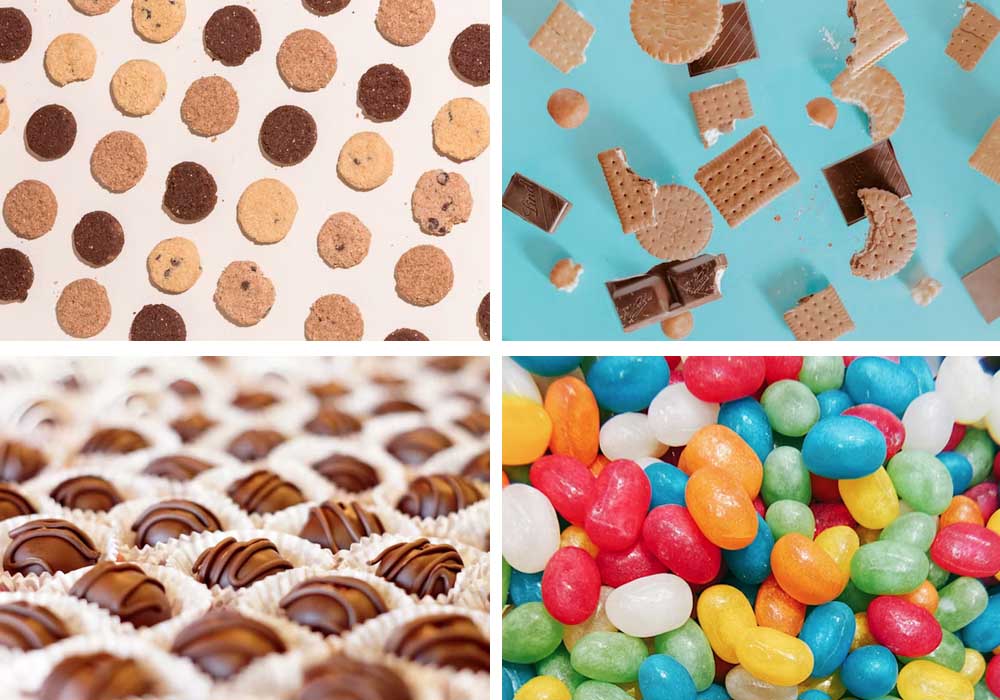Bread Sorting Machine
Chocolate Sorting Machine
Candy Sorting Machine
Biscuit Sorting Machine
What is Bakery and Confectionery Sorting
Bakery and confectionery sorting refers to the precision process of separating various baked goods, sweets, and ingredients based on their color, size, shape, and other optical characteristics using advanced color sorters. This technology ensures that only high-quality products free from defects, discoloration, or foreign materials reach consumers. With increasing quality demands in the food industry, bakery and confectionery sorting has become essential for maintaining product consistency and brand reputation.
Modern sorting solutions cater to a wide range of products including cookies, biscuits, chocolates, candies, dried fruits, nuts, and decorative elements used in baking. These machines help manufacturers eliminate quality issues, improve production efficiency, and meet strict food safety regulations. Whether it's removing burnt items from a cookie line or sorting chocolate pieces by color, automated sorting systems provide unmatched accuracy compared to manual inspection methods.

How Bakery and Confectionery Sorting Works
Bakery and confectionery sorting machines utilize high-resolution CCD optical sensors and advanced imaging technology to analyze each product as it passes through the system. The sensors capture detailed color and shape information, detecting even subtle variations in appearance. When a defective or off-specification item is identified, the machine triggers a precise air ejection system to remove it from the production line.
The sorting process begins with feeding products into the machine, where they are evenly distributed for individual inspection. Sophisticated software algorithms process images in real-time, distinguishing between acceptable and unacceptable items with remarkable accuracy. This ensures only perfect products proceed to packaging, significantly reducing waste and improving overall product quality while maintaining high throughput rates.
Core Features and Benefits of Bakery and Confectionery Sorting
Modern bakery and confectionery sorting solutions offer exceptional accuracy in detecting and removing defects, discolored items, burnt products, and foreign materials. These machines can process hundreds to thousands of items per minute, far exceeding manual sorting capabilities in both speed and consistency. The ability to customize sorting parameters allows manufacturers to adapt the machine for different products and quality standards.
Beyond quality control, these sorting machines contribute to food safety by eliminating potentially harmful contaminants. They help manufacturers reduce labor costs while increasing production capacity, providing excellent return on investment. The non-destructive nature of optical sorting preserves product integrity, ensuring that appearance and texture remain perfect throughout the process.
Technical Specifications of Bakery and Confectionery Sorting Machines
High-performance bakery and confectionery sorters typically feature full-color CCD cameras with high resolutions capable of detecting minute defects as small as 0.2mm. Processing capacities range from 500kg to 5 tons per hour depending on product type and model, with ejection accuracy rates exceeding 99%. Many machines incorporate smart learning algorithms that improve detection accuracy over time as they process more products.
Modern sorters come equipped with intuitive touchscreen interfaces for easy operation and parameter adjustment. Some models feature multi-spectral cameras that can detect defects invisible to the human eye. Hygienic designs with easy-clean surfaces make these machines ideal for food processing environments, while energy-efficient operation keeps running costs low.
Applications of Bakery and Confectionery Sorting Technology
Bakery and confectionery sorting technology finds application across numerous food production sectors, from large-scale biscuit manufacturers to artisanal chocolate makers. It's particularly valuable for premium products where consistent appearance significantly impacts brand perception and market value. The technology plays a crucial role in sorting raw ingredients like nuts, dried fruits, and chocolate chips, as well as finished products ready for packaging.
Specialized applications include detecting and removing burnt items from baked goods, sorting decorated cookies by design accuracy, and ensuring consistent color distribution in mixed confectionery products. The adaptability of these machines allows them to handle everything from delicate pastries to hard candies with equal effectiveness.
Buying Guide
When selecting a bakery and confectionery sorting machine, consider the specific products you'll be processing and their typical defect profiles. Processing capacity requirements should match your production volume, while machine flexibility becomes important if you handle multiple product types. Look for machines with food-grade construction and easy-to-clean designs suitable for bakery environments.
Advanced features like cloud connectivity for performance monitoring and recipe storage for different products can provide significant operational advantages. Consider the machine's sensitivity to product variations and its ability to handle your specific items without damage. Many manufacturers offer product trials to evaluate a machine's performance with your particular bakery or confectionery items.
Maintenance Guide
Regular maintenance is essential for optimal bakery and confectionery sorter performance. Daily cleaning removes food particles and dust that could affect optical sensors, while periodic calibration ensures sorting accuracy remains consistent. Special attention should be paid to ejection mechanisms and conveyor systems which can accumulate sticky residues.
Scheduled professional servicing helps maintain the machine's precision and identifies wear components before they fail. Keeping detailed cleaning and maintenance records ensures food safety compliance and helps predict service needs. Proper shutdown procedures during production breaks help preserve machine accuracy and extend operational lifespan.